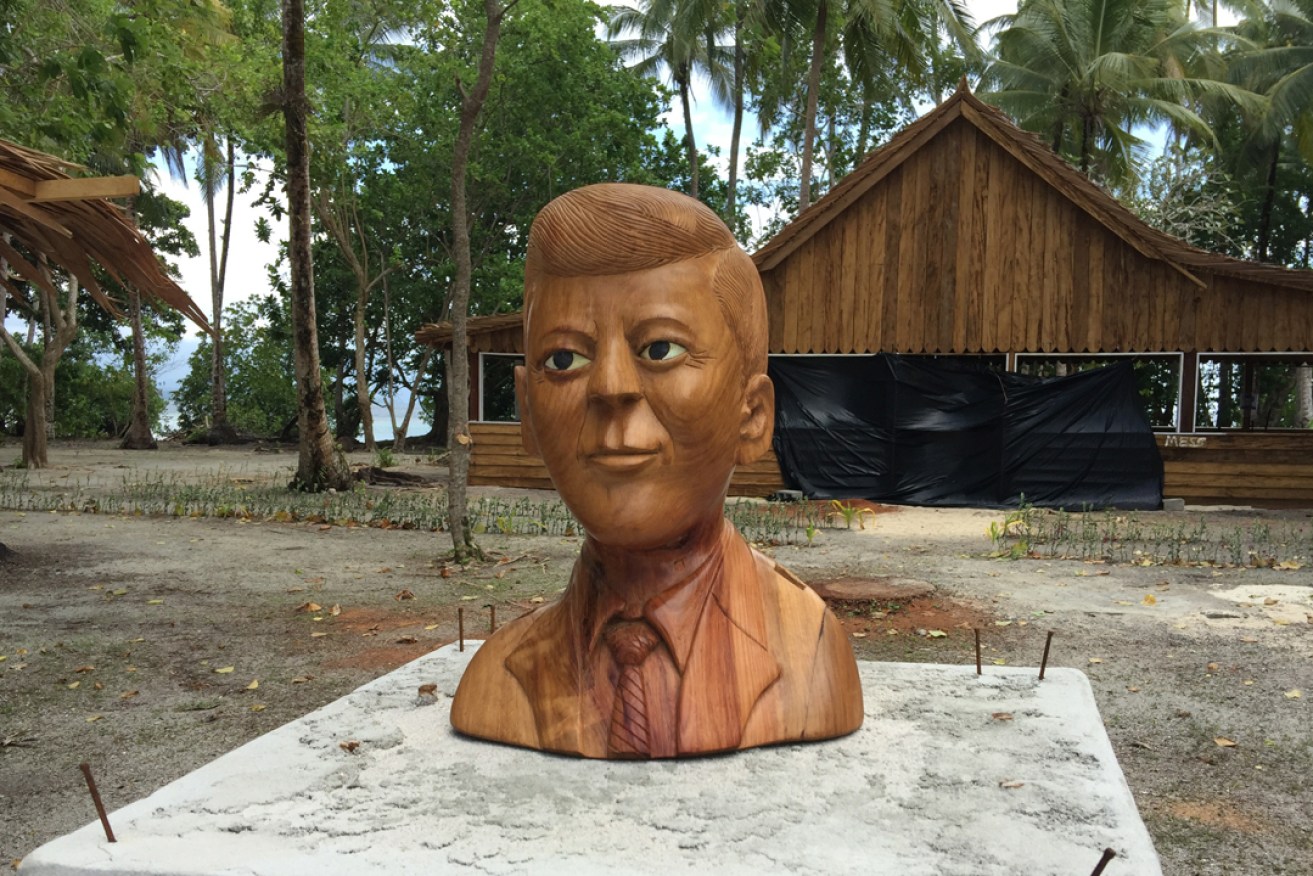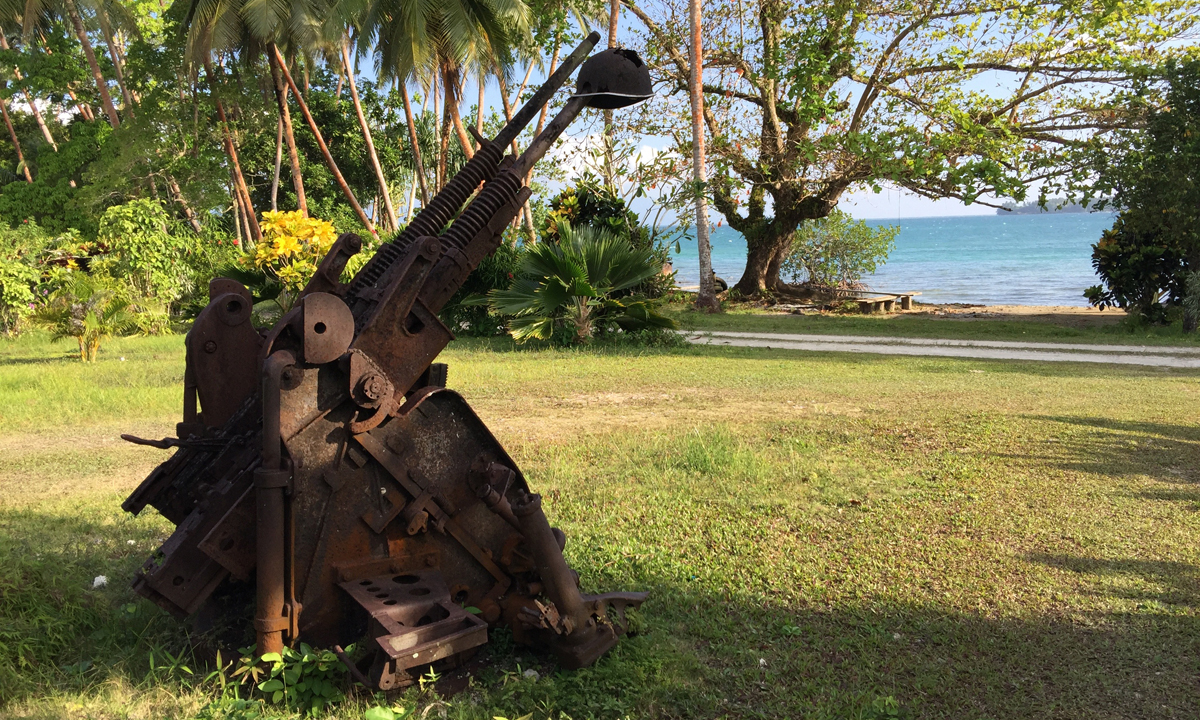Discovering Solomons treasures: from JFK’s bust to Skull Island
It’s probably the last thing you want to hear on an island once ruled by headhunters: “Go get his head!”

A wooden carving of John F Kennedy on Lubaria Island. Photo: Michael Wayne / AAP
The excited local promptly follows his friend’s order and sprints off to a nearby hut, leaving me alone with a slab of cement purporting to be a memorial to US navy lieutenant John F Kennedy.
We’re on Lubaria Island in the Solomon Islands’ Western Province. During World War II, the island was used as a base for the US Navy’s fleet of PT boats. It was here that Kennedy, then a young naval officer, took command of the ill-fated PT-109 in 1943.
And it’s here, decades later, that I’m left stunned as the local man reappears with what’s best described as the Mad Magazine caricature of JFK’s head. He plonks the wooden bust down on its metal pegs and beams at me with a disproportionate amount of pride.
Now, I never served with Jack Kennedy. I didn’t know Jack Kennedy. Jack Kennedy wasn’t a friend of mine. But wooden head, you’re no Jack Kennedy.
The reason for this glowing tribute isn’t just Kennedy’s later fame – it’s his heroics that followed PT-109’s destruction by a Japanese raider on the night of August 2, 1943. He and 10 of the surviving crew swam four hours to a nearby island, with Kennedy towing one badly injured sailor using a lifejacket strap held in his teeth.
His actions made that island famous, but I’m told we’ll visit there later. Maybe the rest of his body is there.
The Solomons are made up of 993 islands, but only around 300 of them are inhabited. The rest are deserted, and often contain a rich history of their own.

A US Marine’s helmet rests on a World War II gun in the front yard of a home in Munda, in the Western Province of the Solomon Islands. Photo: Michael Wayne / AAP
Lubaria Island features a small, rustic museum that showcases relics from the war, including canteens, guns and ammo abandoned after the conflict.
It also features the Kennedy bust. The slightly wonky wooden eyes stare right through me and out into the lagoon where Kennedy once conducted his patrols. It’s time to do the same.
To cruise through a Solomon lagoon is to disrupt a still life. The tumbledown shacks that front the water are peaceful slices of a life unimaginable to most of my generation.
There are no chargers within, no televisions, no refrigerated refreshments. The eyes that stare out from the porches and glassless windows aren’t ruined by years of staring at screens. They see everything.
Which is good, because there’s a lot to see out here. Fish spring from the water en masse, right into the waiting beaks of seabirds. Larger ships haul logs away to far-off destinations.
And banana boats courier wet-behind-the-ears tourists from island to island in the pursuit of some greater context, sometimes following in the wake of giants.
In his haste to save his crew, Kennedy inadvertently chose what would have to be the only island in the Solomons without coconut palms. Despite its delicious name, Plum Pudding Island was tiny and barren. Kennedy single-handedly swam to two neighbouring islands in search of food, and eventually led the men to safety with the help of two islanders and an Australian coastwatcher.
These days, the renamed Kennedy Island is home to a bar and a round-the-clock caretaker.
There’s also a more fitting tribute to JFK, a sign that details his heroic exploits.
The locals have a strange relationship with the Kennedy legacy. The Solomon Islands government erected both memorials this year, clearly timed to make the most of the association with Mr President on his 100th birthday.
Lubaria Island’s inhabitants see it as a means to an end. If it attracts more tourists to their corner of the earth, place all the wooden heads you like.
That may seem cynical, but unlike the various museums and memorials at Dealey Plaza in Dallas, this is undeniably a celebration of life.
It’s a trek to get here, but it’s worth it. The history fills me with awe – I’m actually walking in the man’s footsteps – while the gorgeous natural landscape provides the wonder.
At the end of the path are the skulls, all staring out at the world from a custom-built stone shelf
With presidents and parrots far behind us, our final stop is a celebration of death. I was warned long ago about Skull Island. According to legend, it’s cursed.
When missionaries brought religion to the Solomons in the early 1900s, they took exception to the trophy skulls that were the spoils of the headhunter era.
The missionaries insisted the skulls be moved far away, where they wouldn’t upset or disturb.
The glory of the sport long forgotten, the skulls now sit in eternal exile. Visitors are allowed, but those seeking to disturb the skulls’ slumber must first ask permission to come ashore.
And those who don’t? Straight up cursed.
“Don’t get off the boat first!” my guide Stella warns as we approach the island. It’s surprisingly beautiful: a leafy green jungle sprouts from the centre, while crystalline waves of warm Pacific gently collide with beige sand.
So enticing is the visage that I almost move to get out of the boat before Chris, the boat captain.
He gestures to me to wait, and then, in his native tongue, asks the required permission. It’s an eerie, incongruous sight. You’d normally associate curses and skulls with night-time and thunderstorms, not clear blue skies and a salty sea breeze.
When it’s safe, I leave Stella behind and approach the island. A small path leads up to an ancient wooden gate and into the jungle.
Skull Island doesn’t disappoint. At the end of the path are the skulls, all staring out at the world from a custom-built stone shelf.
They still show the scars of battle. One has a hole through the top of his head.
I feel the thrill of discovery, like an explorer happening upon these bygone artefacts for the first time in centuries.
When we get back to the boat, Stella is still fixed in place. Her eyes stare out to sea, projecting away from whatever’s unsettled her.
I ask her why she chose to remain in the boat.
“Do you know how many times I’ve seen Skull Island?”
Jaded as she is, there’s still an enthusiasm here for the touristy delights only disembodied heads can provide.
The sheer scope of the Sollies means that between Kennedy and cutthroat headhunters lie hundreds of other islands waiting to be explored by intrepid travellers with a good head on their shoulders.
Getting there: The Solomon Islands are around three hours’ flight time from Brisbane, the only Australian capital from which Solomon Airlines departs. Flights to Gizo leave Honiara Airport at regular intervals.
Staying there: Fatboys Resort at Gizo is around 15 minutes from Kennedy Island, and provides views of the island from its restaurant. Visit solomonislandsfatboys.com.au for more info. Tours can be organised through the hotel.
The writer travelled as a guest of Solomon Islands Visitors Bureau.
-AAP




